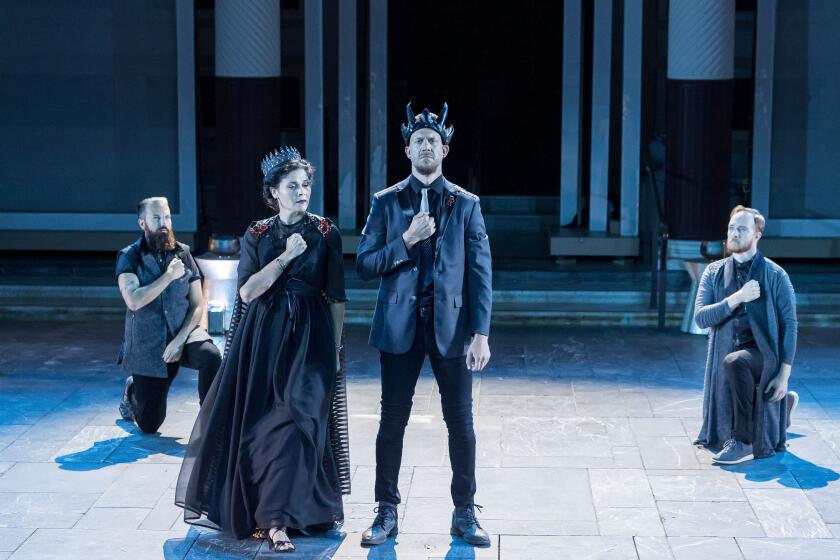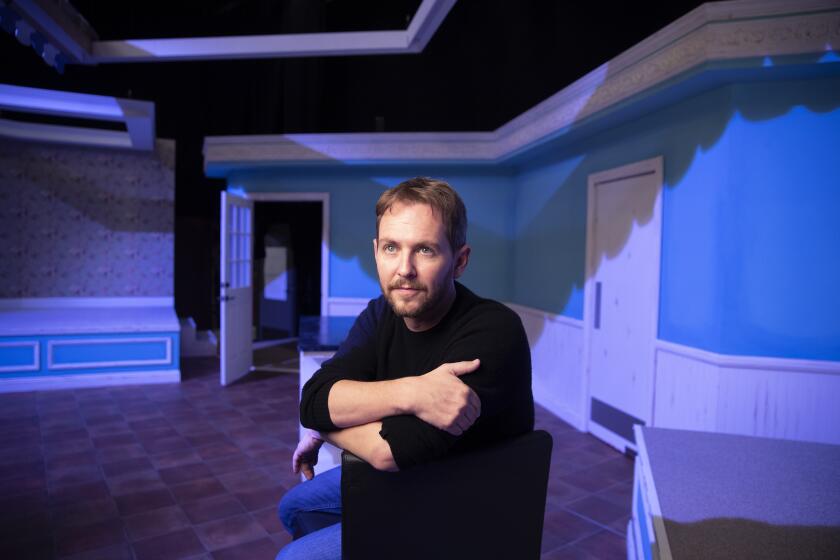Review: Daniel Fish’s brooding, deconstructed ‘Oklahoma!’ electrifies the Ahmanson
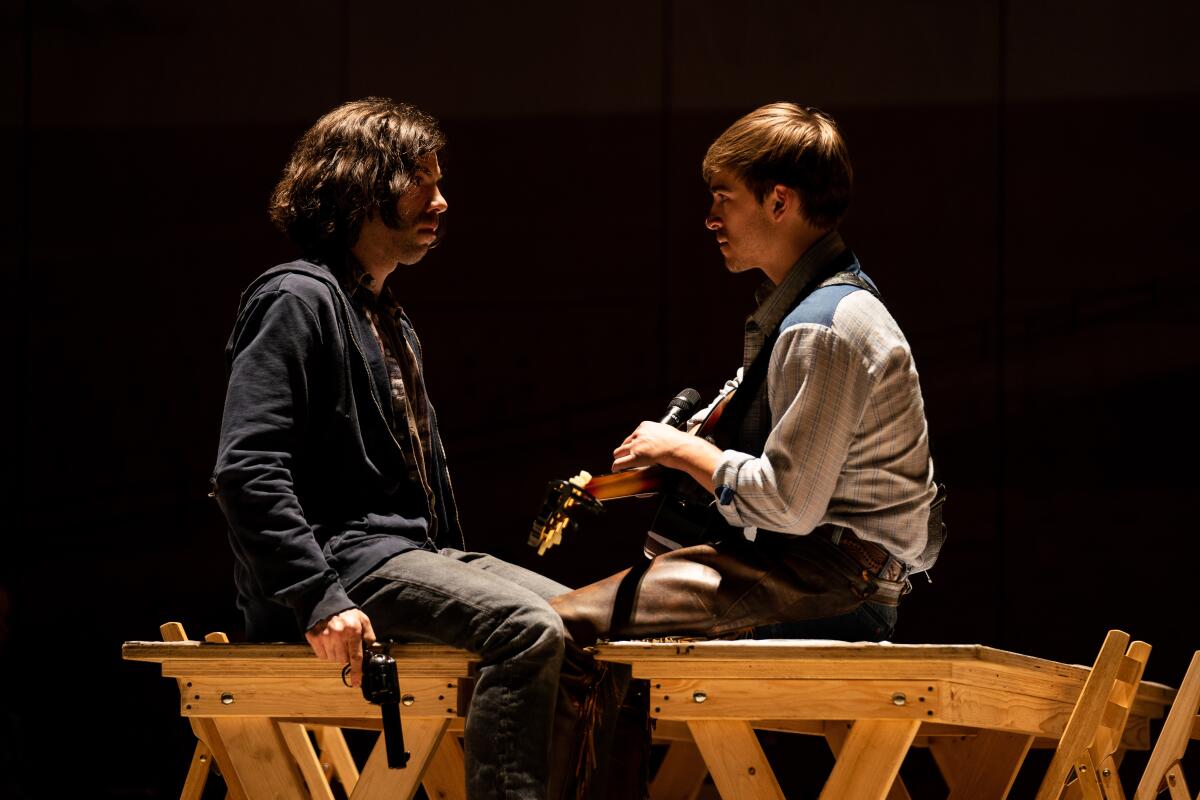
Of all the impressive feats director Daniel Fish pulls off in his thrilling deconstruction of “Oklahoma!,” the most impressive might be that in deromanticizing the musical he somehow manages not to kill off the romance at the heart of the show.
This Tony-winning revival arrives at the Ahmanson Theatre, where it opened Thursday, bearing a multitude of red flags. A “Know Before You Go” email from Center Theatre Group spells out that this modern-dress production features “actors of different races, backgrounds, sexualities, gender identities, and religions in a company of storytellers reflecting the rich diversity of America.”
Standard practice in the upper echelons of the American theater these days, but someone is nervous about something. The source of this anxiety comes into focus later in the email: “What was once seen as a nostalgic and romantic vision of an idealistic prairie community with a tinge of brewing conflict is now a provocative, gritty, and sexy 21st-century commentary on America’s dark and oppressive histories.”
Theatergoers, particularly those with a fondness for the golden age of Broadway, can be militantly protective of classic American musicals. “Oklahoma!” sits at the center of this tradition. But this bracing modern production isn’t trying to start a culture war. It just wants us to see the show with fresh eyes.
The 1943 musical by Richard Rodgers, who wrote the music, and Oscar Hammerstein II, who wrote the book and lyrics, represents a leap in form in the integration of story and song that began years earlier with Hammerstein’s collaboration with Jerome Kern on “Show Boat.” The success of “Oklahoma!” helped consolidate the book musical’s rise over gag-packed revues, in which musical numbers could be passed from one show to another, so tenuous was their relationship to a larger plot.
Fred Zinnemann’s 1955 film, starring Gordon MacRae as Curly and Shirley Jones as Laurey, the stubborn young lovers determined not to betray their feelings for each other, brought “Oklahoma!” and its brilliant Broadway craftsmanship to the masses. But more importantly, the vision of America emanating from the big screen, with its glistening cornfields and folksy goodness and simplicity, was immediately incorporated into a nation’s self-esteem.
“Oklahoma!” is not just a musical but a cornerstone of the American myth. What’s ironic about this is that Hammerstein’s book, derived from Lynn Riggs’ play “Green Grow the Lilacs,” doesn’t stint from showing the sordid underside and lawlessness of American life.
Sexual violence lurks in the background of the story. Laurey hides in the house much of the day to avoid coming into contact with Jud, a hired hand on the farm she runs with Aunt Eller. A social outcast with a shady past, Jud has become obsessed with Laurey, who hears him pacing outside her window at night, like a predator waiting to pounce on a meal it has determined no other competitor will ever enjoy.
Curly is the man Laurey can’t get out of her mind, but her refusal to submit easily to his cocky affections keeps Jud’s hopes alive. When she agrees to go with Jud to a dance social, tensions explode between the men. Threats are made, guns are drawn and justice in the territory of turn-of-the-century Oklahoma, which is not yet a state but on the verge of becoming one, is capricious and sometimes bloody.
While it’s not technically accurate to say, as CTG’s email does, that the “revival is radically different from the original production without changing a word of the original text,” Fish in many respects hews closer than most to what Hammerstein wrote, at least until the ending, which requires some sleight of hand with the script.
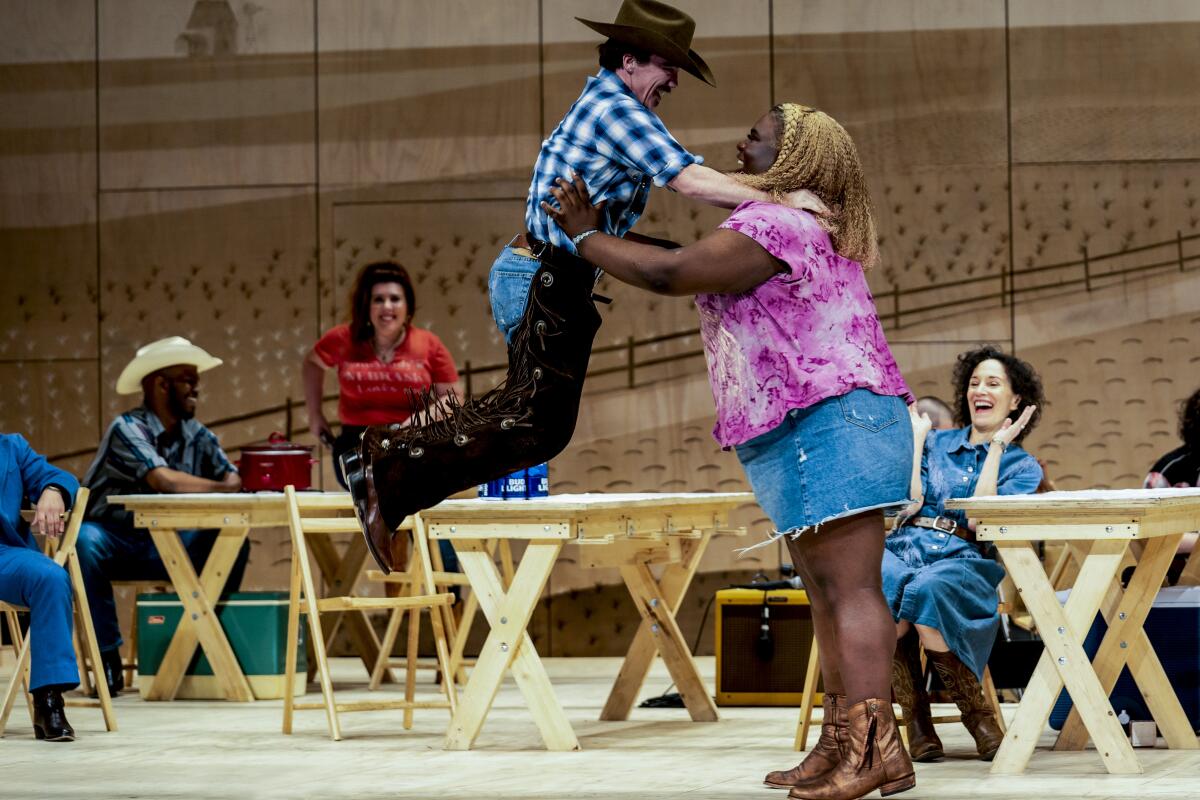
The thrust of Fish’s staging is to get us to hear the musical drama in all its different registers. To that end, the characters speak to one another almost as if they were attending a meeting. Their words, delivered without undue distraction, assume pride of place.
The actors are arrayed on a set by Laura Jellinek that resembles a ramshackle community hall. A backdrop of Oklahoma landscape doesn’t reveal lush farmland but dry, unyielding prairie.
Settlers on this non-Edenic patch of earth must be tough and hardy. It’s no surprise then that the social interactions are rough and tumble. Sex is the main obsession, leaving a festive atmosphere that’s both highly charged and highly dangerous. There’s nothing dainty about the mating rituals in these parts.
Fish maintains a Brechtian distance between actor and role. Curly, played by Sean Grandillo with the guitar-slinging aplomb of a country-and-western recording star, has the straightest of hair. This is a minor disconnect, but it’s winked at by a production that has far more flamboyant tricks up its sleeve.
In defamiliarizing the usual trappings of the musical, Fish changes how it even sounds. The parade of heavenly musical numbers are orchestrated and arranged by Daniel Kluger for 21st century sensibilities. The band, inconspicuous but visible at the back of the set, slides easily between gently traditional and starkly contemporary modes under the music direction of Andy Collopy.
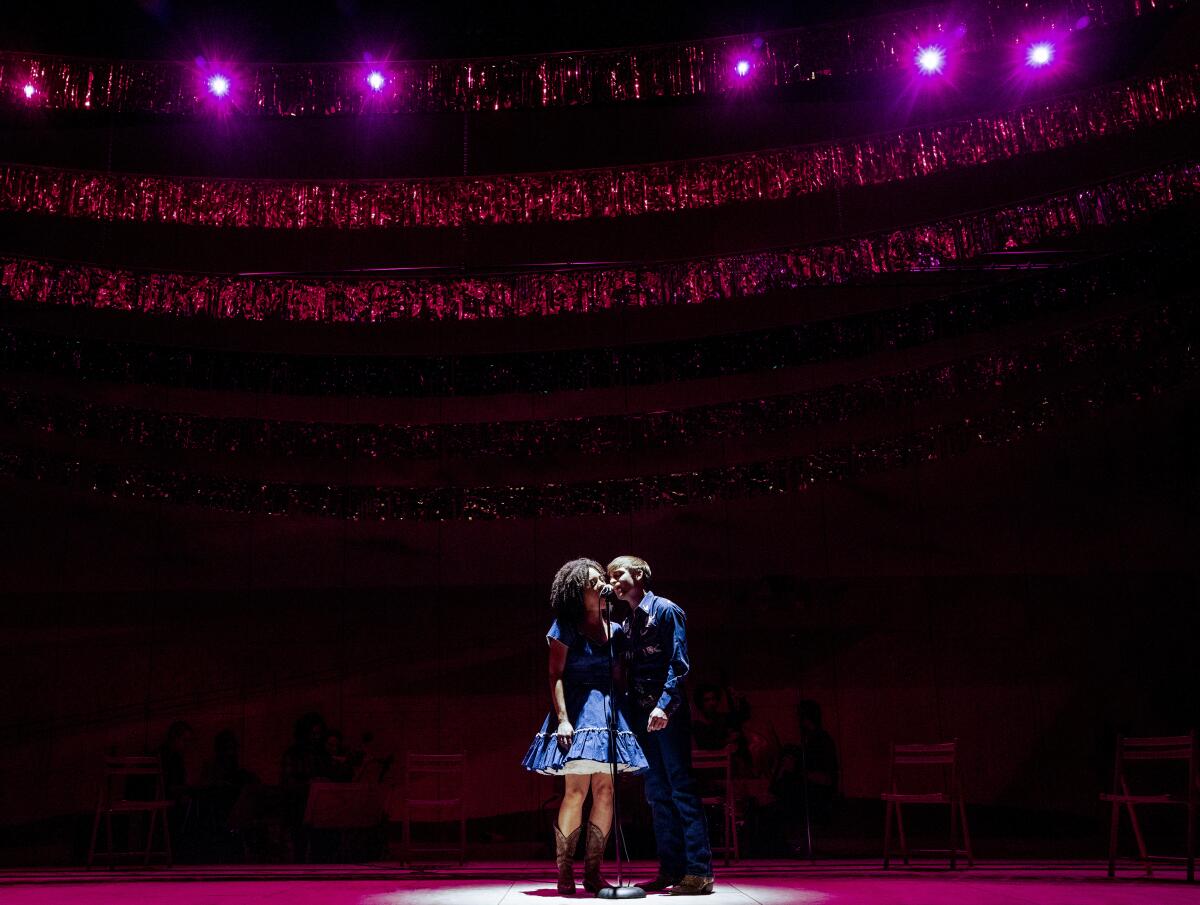
Sasha Hutchings, a Black actor who stars as Laurey and helps lead a multicultural ensemble, breaks up the monolithic whiteness of a musical that sings about the land without thinking too deeply about its complicated history. In her singing, as well as in her acting, Hutchings brings a plucky strength that doesn’t exclude fear, confusion or terrified vulnerability.
At St. Ann’s Warehouse in Brooklyn, where I first saw this revival, and then on Broadway, Ali Stroker played Ado Annie, winning the 2019 Tony for her featured performance — the first actor who uses a wheelchair to do so. Now the role of this libidinously freewheeling comic character is played by Sis, a Black trans performer who infuses her numbers with thunderous energy.
Torn between two possible husbands, Ali Hakim (Benj Mirman), the peddler who enjoys playing the field, and Will Parker (Hennessy Winkler), the simple-minded swain desperate to marry her, Sis’ Ado Annie ricochets like a slippery pinball. When she singingly confesses, “I Cain’t Say No,” she’s not just being cute. This Ado Annie means business.
Jud, the villain of the musical, is a pariah who has to work doubly hard to keep a roof over his head. Christopher Bannow captures the character’s comprehensive loneliness. Sympathy is elicited without sentimentalizing a creep whose addiction to pre-digital-age porn may be the most touching aspect of his character. He suffers from having no one to love him. Unfortunately, the next steps he takes in his deranged path threaten rape and murder.
Fish conducts the scene that takes place in Jud’s lair in engulfing darkness. The blackout ratchets up the menace, but who’s the bad guy in this standoff between rivals for Laurey’s heart? Jud is obviously unhinged, but Curly is cruelly planting suicide as a romantic solution to Jud’s woes.
The lights go out again in a later scene, in which any fellow feeling for Jud is extinguished. Nerves are more frayed at this point, not only because Laurey seems to be in danger but also because of the terrifying gunshots that went off the last time the lights were cut.
Sophocles’ masterpiece has been reimagined in an adventurous production in American Sign Language and spoken English.
Video projections are sparingly introduced to give us close-ups of characters in extremis. The production never wants us to get too comfortable with how the show is proceeding. Indeed, Fish wrests us from any post-intermission relaxation with a reworked dream ballet sequence that begins in heavy-metal mode.
Not all of these daredevil directorial moves are eloquent, and the Ahmanson’s large proscenium stage objectifies the production in a way that distances the audience and subjects the shows to a more detached type of scrutiny. I hated the dream ballet in New York and found it even less expressive in Los Angeles. (No fault of lead dancer Jordan Wynn, who follows the aggressive choreography of John Heginbotham, which might be interpreted as a furious retort to Agnes de Mille’s groundbreaking achievement.)
Barbara Walsh upholds Aunt Eller’s standing as the soul of normality, even if normal is now being looked at more critically, if not cynically. Her role in the modified ending, which accentuates the bloodshed that the characters quickly hope to put behind them, may be the most chillingly faithful feature of this revamped revival.
Some may prefer “Oklahoma!” the old-fashioned way. But for those open to discovering the haunting underside of a sneakily complex musical, this production is boldly, brazenly alive.
A final word of warning to prospective theatergoers: You may never hum “Oh What a Beautiful Mornin’” with the same lightheartedness again.
What does Matt Shakman’s decision to step down as as artistic director of the Geffen Playhouse say about the theater’s future?
'Oklahoma!'
Where: Ahmanson Theatre, 135 N. Grand Ave., L.A.
When: 8 p.m. Tuesdays through Fridays, 2 and 8 p.m. Saturdays, 1 and 6:30 p.m. Sundays. Ends Oct. 16. (Call for exceptions)
Tickets: $35-$150 (subject to change)
Information: (213) 972-4400 or centertheatregroup.org
Running time: 2 hours, 45 minutes, including one intermission
COVID protocol: Masks are required at all times. (Check website for changes.)
More to Read
The biggest entertainment stories
Get our big stories about Hollywood, film, television, music, arts, culture and more right in your inbox as soon as they publish.
You may occasionally receive promotional content from the Los Angeles Times.
